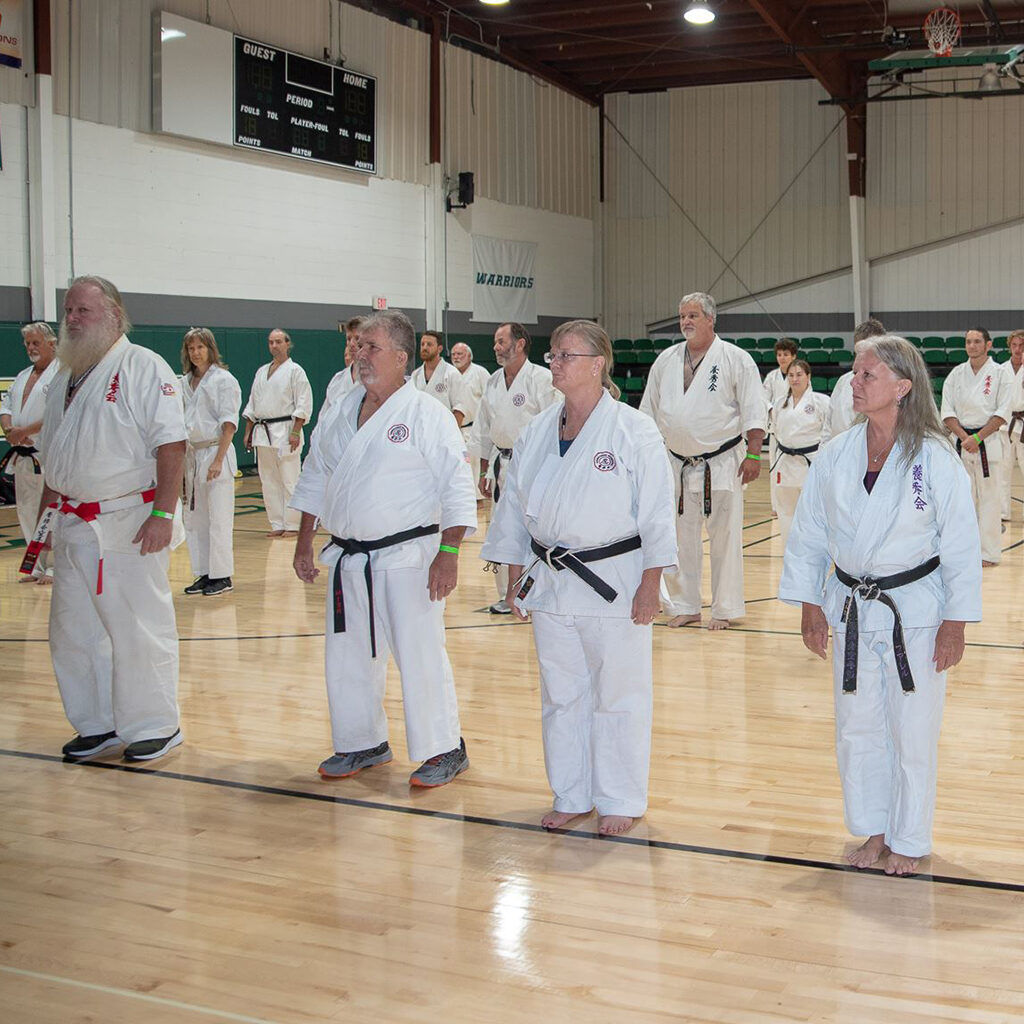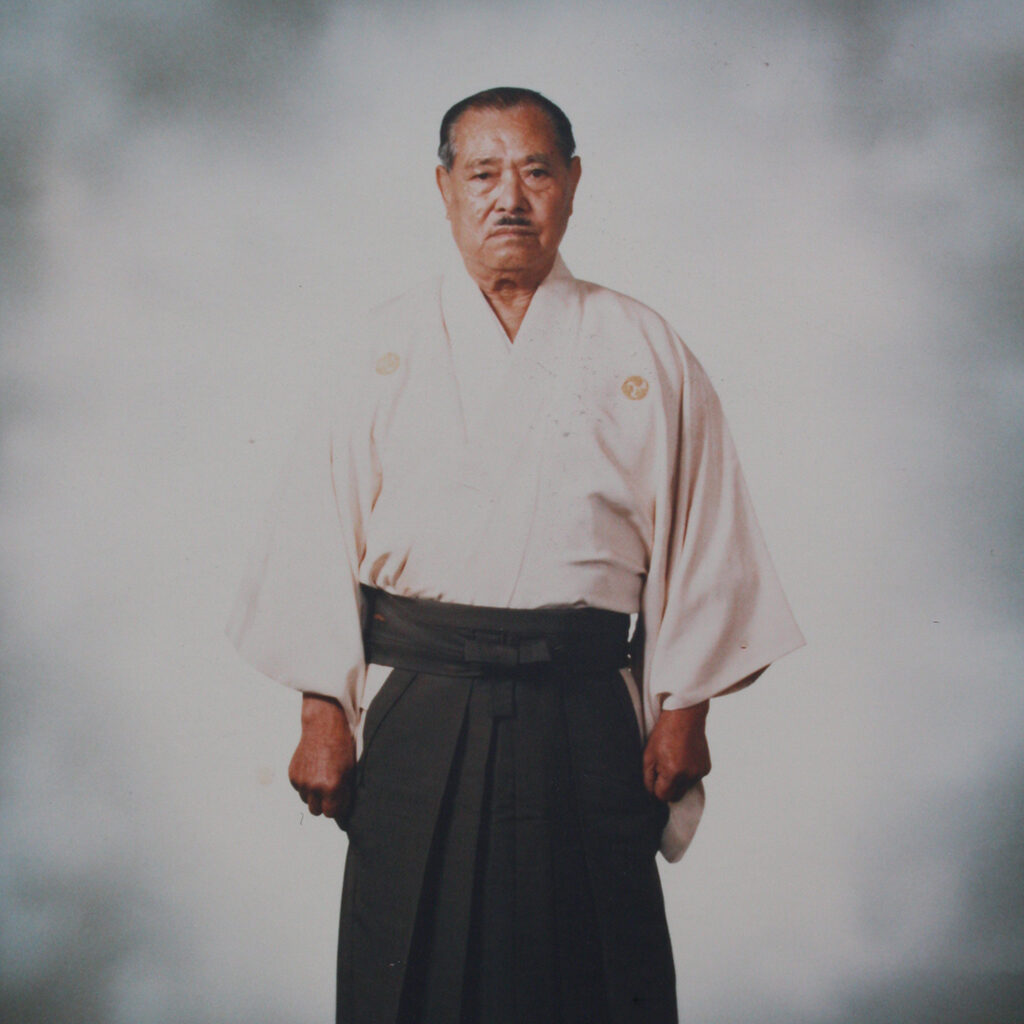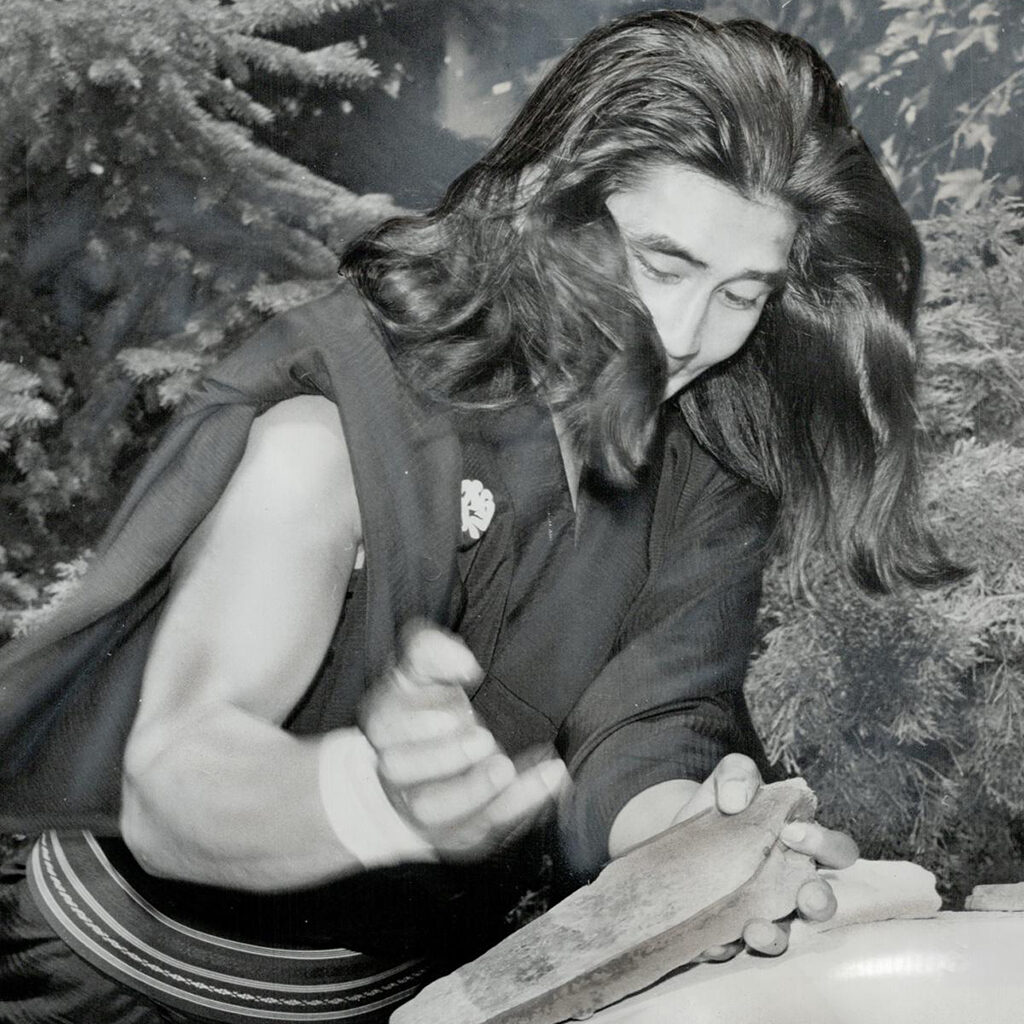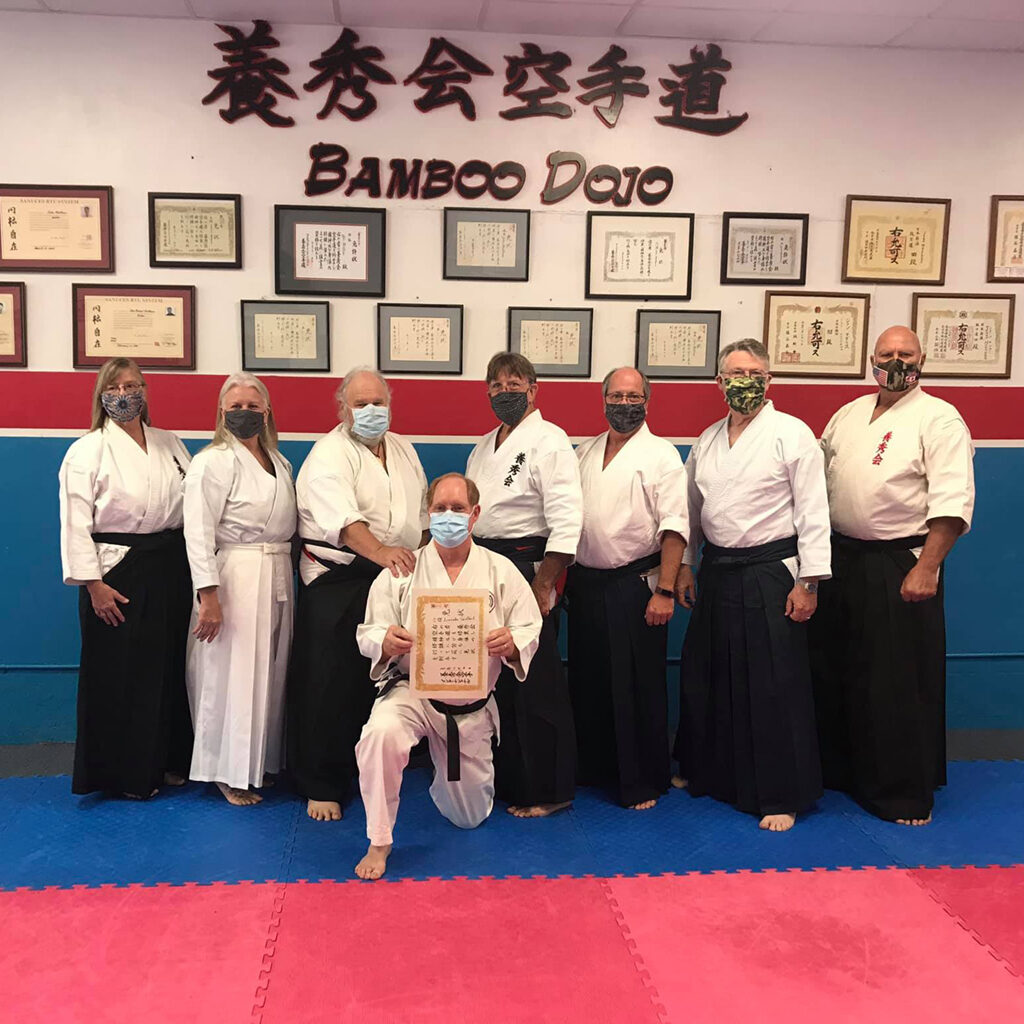The History of Yoshukai Karate
Yoshukai means training hall of continuing improvement and development
History and Lineage of Karate
A Short Historical Excerpt
The history and lineage of Karate can be traced back to Okinawa over three hundred years ago. Okinawa was a trading partner with China and the lands of the Far East. Much of the martial arts influence came from China. In the early 1500’s the Okinawan King banned the ownership of weapons. This small island was located between China and Japan, leading to conflicts from both sides. In the early 1600’s Japan invaded and conquered Okinawa; being unarmed played a major role in the birth of karate (empty hand) combat, the art we know today.
Many of the great masters of karate came from the villages of Shuri (the capital of Okinawa), Naha, and Tomari (seaports). They would spend a lifetime studying this art. When karate became popular in Japan in the 1920’s (largely due to Funakoshi), Okinawan masters organized their local arts for national recognition to distinguish the different type of karate they were teaching in the three towns coined “Shuri-te,” “Naha-te,” and “Tomari-te.” The development and influence of Shuri-te by Bushi Matsumura (1797-1889?) and Yasutsune Itosu is also known as linear hard-style Shorin karate. This style uses speed and impact and thought to destroy the opponent. Naha-te is known as a soft-style, circular karate, or the Shorei style.

Chinen Tsuyoshi
Founder of Chito-Ryu
Chinen Tsuyoshi born in 1898 was the grandson of “Bushi” Matsumura on his father’s side. Though his father was not involved in the martial arts, the young boy had access to the finest instructors on the islands. He began his studies under Arakaki Seisho (1840-1918) which was his first instructor at the age of seven. Chinen Tsuyoshi’s childhood teacher in elementary school was none other than Funakoshi Gichin (1868-1957), who would later introduce karate to Japan. Chinen Tsuyoshi changed his name to Tsuyoshi Chitose and moved to Japan to attend the University of Tokyo’s Medical School. During his college years (1922-1932?) he practiced karate in his spare time, and assisted his old school teacher Gichin Funakoshi with his karate classes. In 1936 Dr. Chitose was present at a meeting of Okinawan karate authorities in Naha, Okinawa. This was the meeting in which the translation ” Empty Hand Way” was actually adopted for Karate-do in place of the original todejutsu or “Chinese Hand Method”. Chito-Ryu Karate was developed and named by master, Dr. Tsuyoshi Chitose in the late 1940’s. The meaning of “Chito” is a derivation “Chi” a “thousand” and “to” is from the Chinese “Tang”, hence the translation of Chito-Ryu is “The thousand year old Chinese (Tang dynasty) way”, signifying the ultimate origin of Karate as being from China during the Tang era roughly one thousand years ago. Chitose would continue his study and involvement with karate for the next 79 years until his death in 1984.

Dr. Chitose and Yamamoto Sensei
Founders of Chito-Ryu and Yoshukai Karate
Mamoru Yamamoto was a fifteen year old boy when he began his training with Dr. Chitose. With the guidance of Dr.Chitose, Yamamoto became one of his top students, and was an active competitor in the Japanese National Tournament Circuit. He retired undefeated as the All Japan Karate Champion in 1961. Dr. Chitose pronounced him the Master of his own style, giving this style the name of Yoshukan. Two years later, Master Yamamoto established the first Yoshukan Dojo. In 1963 Dr. Chitose visited Yamamoto and saw the development of the system with the potential for growth through Yamamoto’s work. He changed the 3rd kanji of their branch’s name from “kan” – meaning to stand alone – to “kai” – meaning association.

Yamamoto Sensei and Mike Foster
Founders of Yoshukai Karate and Yoshukai Karate International
During the following year Yamamoto would accept a new student Mike Foster, who was a 2nd Dan in Goju-Ryu. Mike Foster was stationed at Itazuke Air Force base in the late 1950’s and studied with Sensei Watanabe who taught Goju karate at the Itazuke Administration Annex base gym. He would earn both Sho Dan and Ni Dan rank from Sensei Watanabe. Mike Foster was sent back to the United States in 1963. After recovering from respiratory problems Mike Foster went back to Japan in 1964. His former instructor Sensei Watanabe was good friends with Sensei Mamoru Yamamoto, who would visit the gym twice a month. At this time Mike Foster was introduced to Yamamoto who trained under Dr Chitose. Foster would train under Yamamoto for the next four years, returning to the U.S. for short periods of time. Foster received his 3rd Dan rank on October 20th 1964 from Chitose/Yamamoto. He then received his 4th Dan on October 20th 1965, 5th Dan on June 10th 1969, 6th Dan on January 17th 1971, and 7th Dan on Feb 15th 1976. Foster was Yamamoto’s representative in the U.S. during the mid 60’s. His mission was to expand the number of Yoshukai schools in America. Sensei Foster became the United States karate champion in kumite for the years 1966, 1967, 1968 and 1969. He was known as the Fighting Sensei. In 1971 Mamoru Yamamoto split from his instructor Dr. Tsuyoshi Chitose (10th Dan, the founder of Chito-Ryu Karate) and withdrew from the Japanese Chito-kai Karate Federation. Foster would follow Yamamoto until the late 70’s when he would move on to start his own association.

Mike Foster
Founder Yoshukai Karate International
Mike Foster’s Yoshukai International Karate Association would grow to include portions of the United States; Florida, California, Alabama, Georgia, Illinois,and Puerto Rico. The international countries included Vancouver British Columbia Canada, Germany, Latvia, Australia, and New Zealand. In 1990, Mr. Foster formed the Yoshukai International Karate Association’s testing board to provide a standardized ranking method for student being promoted to the dan ranks of his system. The board’s Executive Director Michael McClernan, along with a testing board consisting of 4th degree black belts and above was divided into two separate boards, one for kata and one for kumite. The board was overseen by Sensei Foster. After twenty-seven years of holding the rank of 7th Dan, Sensei Foster was promoted to the rank of Ku Dan (9th degree black belt) and given the title of Hanshi (Master Instructor) at a ceremony on May 17, 2003 in Titusville FL. The rank and title were bestowed by the Shihan and Renshi classes of Mike Foster’s Yoshukai International Karate Association. Yoshukai International Karate is a direct descendant of Chitose (Chito-Ryu). Foster received senior rank through Chitose and Yamamoto. He has taken this knowledge and evolved the art with his own personal style.

Yoshukai Karate International
Governed by the Yoshukai Testing Board
The Yoshukai Testing Board, Inc.’s board members consists of Michael McClernan, William Moore, Bob Bush, John Matthews, Ricky Copeland, Richard Cromwell, Christina McClernan, Lee Farrell Michael Mendelson, and Eddie Machen resigned from Mike Foster’s Yoshukai International Karate Association on June 28, 2008 due to differences in management philosophy. The Board functions as a not for profit corporation doing business as Yoshukai Karate International.

